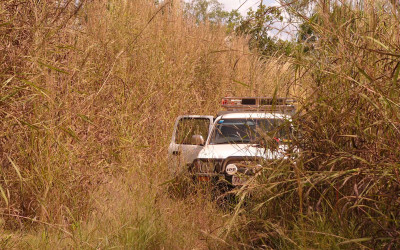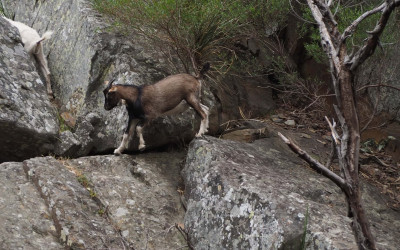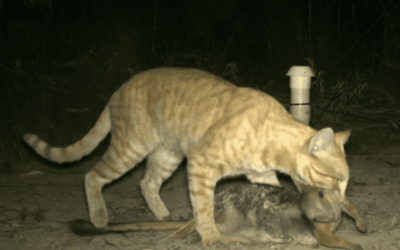MEET THE INVADERS
Foxes
If you think of foxes, you might picture the sly trickster of folklore – a sometimes devious and clever escape artist. And in many ways, the red fox (Vulpes vulpes) lives up to the legend.
It is an animal built for survival. Slipping seamlessly and often undetected between wilderness, farmland and city streets.
With a reddish-brown coat, white underbelly and distinctive black markings on their lower legs, red foxes are instantly recognisable. Their bushy tail, tipped in white, is their unmistakable signature.
Though small – adults rarely exceed 14 kilograms – they are a powerhouse of agility, endurance and intelligence.
Foxes mate in winter, with females giving birth to 4–5 cubs. By autumn, the young foxes disperse, travelling astonishing distances of up to 300 kilometres in search of new territory. Their finely tuned senses give them a hunter’s edge – large, pointed ears pick up the faintest scurry of prey beneath the undergrowth, while their sharp muzzle and keen nose guide them to their next meal, even if it’s buried.
And when it comes to food, foxes are the ultimate opportunists. As omnivores, they eat pretty much anything from small mammals like rodents and rabbits, to birds, reptiles, insects, plants or even a meal from an unattended picnic!
In their native range across Europe, North America, North Africa and the Middle East, foxes are kept in check by formidable predators like coyotes, bears, wolves and golden eagles.
But where these predators and diseases are absent, like in Australia, fox numbers soar.
Invasion story
Wealthy settlers, longing for a taste of home and the thrill of a fox hunt, began bringing over a few red foxes from Europe, with at least 9 shipments between 1845 and 1879. Some were released straight into the bush, while others were kept in enclosures for hunting – until they found their own way out.
Early releases near Geelong and Ballarat in Victoria didn’t immediately take off, but by 1874, foxes had gained a foothold in the Werribee district. From there, they wasted no time. By 1878, they were swarming between Geelong and Melbourne.
By 1905, they were in South Australia and by 1907, they’d crossed into New South Wales and Queensland. Within 50 years, they’d conquered about 80% of the entire mainland.
Their secret weapon? The booming rabbit population. Some farmers, seeing an opportunity for free pest control, even helped spread them further.
Today, the fox population in Australia is estimated to be around 1.7 million.
They can be found across most of Australia, except for the tropical north, Tasmania and about 50 offshore islands.
How did we get here?
Initially the governments of the time did not recognise the danger that foxes posed to the environment and agriculture.
Opposition to the introduction of foxes was voiced as early as 1860. Legislation against their introduction was suggested, but not followed through.
By the 1880s, the fox problem had become impossible to ignore. Farmers were furious. Foxes were killing lambs and poultry, cutting deep into profits. Yet there was still no serious effort to stop them. The Victorian government finally responded in 1883, officially declaring foxes ‘vermin’ under the Mallee Pastoral Leases Act. But a label meant nothing without action and fox numbers kept climbing.
South Australia started offering bounties for fox scalps in 1889, a sure sign that officials were beginning to realise they had a serious pest on their hands. Victoria soon followed suit. But bounties were an ineffective form of control and did little to curb the fox population.
Fast-forward to 1999, and the red fox was officially listed as a Key Threatening Process under the EPBC Act. A national plan, called a Threat Abatement Plan was drawn up, in recognition that foxes are one of the biggest threats to Australia’s native wildlife.
Since then, governments across the country have rolled out large-scale control programs, relying on a mix of baiting, exclusion fencing, targeted shooting and some bounties.
A review of Australian bounties found they typically result in the death of less than 10% of targeted feral animal populations. To reduce fox numbers, some two-thirds may need to be killed each year.
The toll on nature
Foxes are among the most damaging invaders in Australia’s history.
Our native species haven’t evolved defences against this cunning predator, and the consequences have been brutal. As many as 16 mammals have gone extinct mainly or partly because of foxes.
Foxes kill about 300 million native animals every year, including 88 million reptiles, 111 million birds and 107 million mammals. Their prey includes threatened species like the great desert skink, Fitzroy river turtle, malleefowl, little penguin, and half of Australia’s threatened land mammals.
Reintroduction programs for these species sometimes fail because foxes quickly move in, wiping out populations before they can establish themselves.
Frogs and reptiles are also on the menu, but the impact of foxes on their populations is hard to measure.
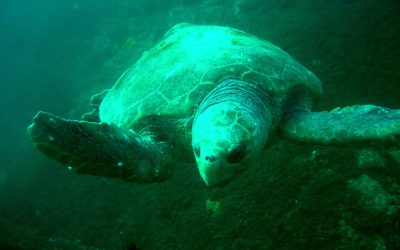
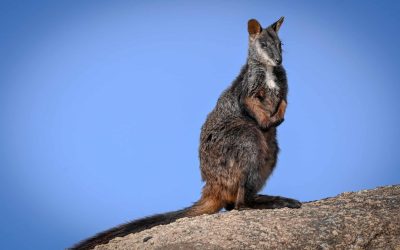
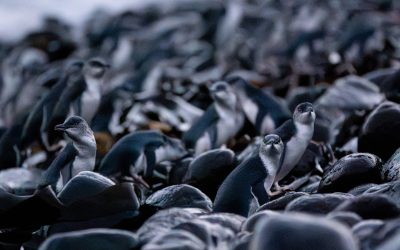
Cultural consequences
Foxes are a threat to Indigenous culture due to the deep cultural connections they have to the species foxes are driving to extinction. Freshwater turtles for example are a significant part of Aboriginal culture, as part of dreamtime stories, art, cultural practice and ceremony, and as customary food sources.
How do we fix this?
Managing foxes in Australia is no easy feat. They are intelligent, adaptable and prolific breeders, capable of rapidly recolonising areas where control efforts have taken place.
But the stakes are high – without sustained and strategic action, native species will edge closer to extinction.
Efforts to control foxes hinge on reducing their numbers while also strengthening the resilience of native wildlife. Large-scale baiting programs using 1080 poison remain the most widely used method, particularly when coordinated across properties.
Australia has global obligations, legal and moral, to prevent extinctions and recover threatened species, and until we find a replacement 1080 is a vital part of the toolkit to protect our native species. Unfortunately, this is the choice we have to make between urgently reducing the number of foxes or accepting the extinction of more native animals.
Exclusion fencing has also proven effective in protecting critical populations, preventing foxes from accessing vulnerable species like bettongs, ground-nesting birds and turtles.
Targeted conservation measures, such as nest protection programs, have also been implemented for species at high risk, like malleefowl and seabirds.
Trapping, shooting, and den fumigation are also used, though foxes quickly learn to evade these threats.
Despite these efforts, major challenges remain. Foxes are incredibly adaptable, learning to avoid traps and baits over time. Their ability to quickly recolonise controlled areas means that management must be ongoing, not just a one-off intervention
There have been success stories. Fox eradication efforts on islands such as Phillip Island have shown that it is possible to remove them entirely from isolated environments.
Some mammal reintroduction programs have also succeeded when combined with effective fox control, helping species reclaim lost territory.
However, to truly turn the tide, fox management needs more than just boots on the ground – it needs political will. Advocacy is crucial for securing better funding, ensuring that conservation programs aren’t left to wither due to budget cuts.
There is also a need to push for greater integration of Indigenous knowledge, shifting from ‘engagement’ to true collaboration where First Nations expertise shapes conservation strategies.
More research, better coordination between governments, and a holistic approach that combines lethal control, habitat restoration and community involvement will be key to long-term success.
Effective fox control programs rely on using as many tools as possible in a coordinated and integrated way across a broad area. Because foxes have a high reproduction rate and are known to be able to travel long distances, ongoing management is vital to keep populations low, reduce chances of re-invasion and keep impacts to an acceptable level. Effective control is more than just about removing foxes. The average number of foxes needed to be removed each year to stop population growth is 65% depending on conditions and birth rates. You need to remove more than the number of cubs being born and surviving to be effective.
Gillian Basnett National Feral Cat and Fox Management Coordinator Centre for Invasive Species Solutions
FAQs
Foxes were deliberately introduced into Australia for hunting purposes, as were rabbits, hares, deer, and other game animals. They were brought to Victoria in the mid-1800s.
Foxes became established in the 1870s following releases in southern Victoria, particularly in the Werribee-Geelong area. They quickly spread across the southern part of the continent, reaching the Adelaide district of South Australia by 1905 and the Queensland/New South Wales border by 1907. By 1920, they were in north-western Queensland. The availability of rabbits and hares, as well as the control of dingoes, aided their spread.
Foxes are considered a major threat to Australian native species. They have contributed to the extinction of an estimated 16 native mammal species and continue to cause population declines in many others. Foxes prey on a wide variety of native animals, including mammals, birds and reptiles. Foxes also engage in surplus killing, which is when they kill more prey than they can eat.
Foxes are primarily carnivorous, but they are opportunistic feeders and eat a wide range of animal and plant material. Their diet includes rabbits, rodents, frogs, birds, insects, fruit, vegetables and grain. They also consume carcasses, particularly of sheep and lamb. In urban areas, they may eat small birds, worms, insects, fruit and pet food left out by residents.
Fox control measures include trapping, shooting, den fumigation, and exclusion fencing. Poison baiting using 1080 is the most common method. Baiting can reduce fox activity by 50–97%, but the effectiveness is variable and foxes can recolonise rapidly.
Queensland Government. (n.d.). Fox Fact Sheet. Queensland Government.
Abbott, I. (2011). The importation, release, establishment, spread, and early impact on prey animals of the red fox Vulpes vulpes in Victoria and adjoining parts of south-eastern Australia. Australian Zoologist, 35(3), 463-531.
Fairfax, R. J. (2019). Dispersal of the introduced red fox (Vulpes vulpes) across Australia. Biological Invasions, 21, 1259-1268.
Hull, G. (2021). The Ferals that ate Australia. Black Inc.
Saunders, G. R., Gentle, M. N., & Dickman, C. R. (2010). The impacts and management of foxes Vulpes vulpes in Australia. Mammal Review, 40(3), 181-211.
Stobo-Wilson, A., et al. (2022). Estimates of numbers of animals killed by cats and foxes in Australia. Diversity and Distributions.
Fleming, P. A., et al. (2021). Diet of the introduced red fox Vulpes vulpes in Australia: analysis of temporal and spatial patterns. Mammal Review, 51(4), 508-527.
Georges, A., et al. (2023). Australian Turtles in Trouble. Austral Ecology.
Kirkwood, R., et al. (2014). Control of red foxes on Phillip Island, Australia: a case study in eradication feasibility. Wildlife Research, 41, 667-676.
Dielenberg, J. et al., 1.7 million foxes, 300 million native animals killed every year, ANU College of Science and Medicine News, 16 March 2022, https://science.anu.edu.au/news-events/news/17-million-foxes-300-million-native-animals-killed-every-year-now-we-know-damage.
- Queensland Government. (n.d.). Fox Fact Sheet. Queensland Government.
- Abbott, I. (2011). The importation, release, establishment, spread, and early impact on prey animals of the red fox Vulpes vulpes in Victoria and adjoining parts of south-eastern Australia. Australian Zoologist, 35(3), 463-531.
- Fairfax, R. J. (2019). Dispersal of the introduced red fox (Vulpes vulpes) across Australia. Biological Invasions, 21, 1259-1268.
- Hull, G. (2021). The Ferals that ate Australia. Black Inc.
- Saunders, G. R., Gentle, M. N., & Dickman, C. R. (2010). The impacts and management of foxes Vulpes vulpes in Australia. Mammal Review, 40(3), 181-211.
- Stobo-Wilson, A., et al. (2022). Estimates of numbers of animals killed by cats and foxes in Australia. Diversity and Distributions.
- Fleming, P. A., et al. (2021). Diet of the introduced red fox Vulpes vulpes in Australia: analysis of temporal and spatial patterns. Mammal Review, 51(4), 508-527.
- Georges, A., et al. (2023). Australian Turtles in Trouble. Austral Ecology.
- Kirkwood, R., et al. (2014). Control of red foxes on Phillip Island, Australia: a case study in eradication feasibility. Wildlife Research, 41, 667-676.
Dielenberg, J. et al., 1.7 million foxes, 300 million native animals killed every year, ANU College of Science and Medicine News, 16 March 2022, https://science.anu.edu.au/news-events/news/17-million-foxes-300-million-native-animals-killed-every-year-now-we-know-damage.






